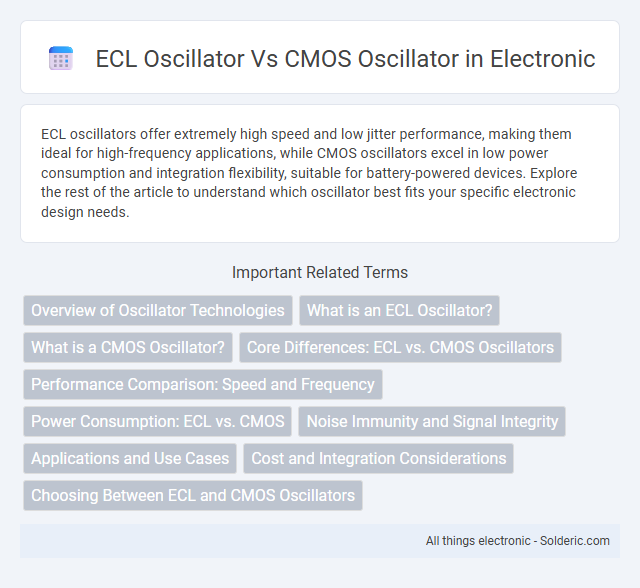ECL oscillators offer extremely high speed and low jitter performance, making them ideal for high-frequency applications, while CMOS oscillators excel in low power consumption and integration flexibility, suitable for battery-powered devices. Explore the rest of the article to understand which oscillator best fits your specific electronic design needs.
Comparison Table
| Feature | ECL Oscillator | CMOS Oscillator |
|---|---|---|
| Technology Type | Emitter-Coupled Logic | Complementary Metal-Oxide-Semiconductor |
| Speed | Very high frequency, up to several GHz | Moderate frequency, typically up to hundreds of MHz |
| Power Consumption | High power consumption | Low power consumption |
| Signal Swing | Small voltage swing (~800 mV) | Large voltage swing (rail-to-rail) |
| Output Waveform | Square wave with low jitter | Square wave with moderate jitter |
| Noise Performance | Low phase noise | Higher phase noise compared to ECL |
| Integration | Less integration friendly | Highly integration friendly in ICs |
| Typical Applications | High-speed communication, radar systems | General-purpose clocks, microcontrollers |
Overview of Oscillator Technologies
ECL oscillators offer extremely high-speed switching capabilities and low jitter, making them ideal for ultra-fast digital circuits and high-frequency applications. CMOS oscillators are favored for their low power consumption, ease of integration, and cost efficiency, commonly used in power-sensitive and portable devices. Understanding your application's frequency stability, power constraints, and speed requirements helps determine whether an ECL or CMOS oscillator best suits your design needs.
What is an ECL Oscillator?
An ECL oscillator is a high-speed electronic oscillator that utilizes emitter-coupled logic (ECL) transistor pairs to generate fast and stable clock signals with minimal phase noise. It excels in applications requiring rapid switching speeds and low jitter, outperforming CMOS oscillators which are typically slower but more power-efficient. Your choice between ECL and CMOS oscillators should consider speed requirements, power consumption, and signal integrity needs.
What is a CMOS Oscillator?
A CMOS oscillator is an electronic oscillator circuit built using complementary metal-oxide-semiconductor (CMOS) technology, known for its low power consumption and high noise immunity. It generates stable frequency signals suitable for timing applications in digital circuits. Your choice between CMOS and ECL oscillators depends on power efficiency and speed requirements, as CMOS is ideal for low-power environments while ECL offers higher speeds but consumes more power.
Core Differences: ECL vs. CMOS Oscillators
ECL oscillators use emitter-coupled logic technology and operate at very high frequencies with low propagation delay, making them ideal for ultra-fast digital circuits. CMOS oscillators leverage complementary metal-oxide-semiconductor technology, offering low power consumption and better noise immunity, preferred for battery-powered and integrated applications. Core differences lie in speed, power consumption, and noise characteristics, where ECL excels in high-speed performance and CMOS dominates in energy efficiency and integration scalability.
Performance Comparison: Speed and Frequency
ECL oscillators offer superior speed and higher frequency capabilities compared to CMOS oscillators, often operating in the gigahertz range due to their differential design and low voltage swing. CMOS oscillators prioritize power efficiency and integration but typically achieve lower maximum frequencies, usually in the hundreds of megahertz to low gigahertz range. Your choice depends on whether ultra-high speed or lower power consumption is more critical for your application.
Power Consumption: ECL vs. CMOS
ECL oscillators exhibit higher power consumption due to their continuous current flow, typically in the range of several tens of milliwatts, making them less energy-efficient compared to CMOS oscillators. CMOS oscillators operate with significantly lower power levels, often microwatts to a few milliwatts, leveraging the switching nature of CMOS technology to minimize energy dissipation. Power efficiency in CMOS oscillators is advantageous for battery-powered and portable applications, whereas ECL oscillators prioritize speed over power savings.
Noise Immunity and Signal Integrity
ECL oscillators provide superior noise immunity and signal integrity due to their differential design and constant current operation, minimizing voltage swings and electromagnetic interference. CMOS oscillators, while more power-efficient, are more susceptible to noise and signal degradation from voltage fluctuations and crosstalk. Choosing ECL technology enhances your circuit's robustness in high-speed, noise-sensitive applications where signal integrity is critical.
Applications and Use Cases
ECL oscillators excel in high-frequency applications such as telecommunications, radar systems, and high-speed data converters where low jitter and fast switching are crucial. CMOS oscillators are favored in battery-powered devices, microcontrollers, and consumer electronics due to their low power consumption and ease of integration. Your choice depends on whether you prioritize speed and signal integrity (ECL) or energy efficiency and cost (CMOS).
Cost and Integration Considerations
ECL oscillators generally exhibit higher power consumption and complexity, leading to increased cost compared to CMOS oscillators, which are more cost-effective due to lower power requirements and simpler fabrication processes. CMOS technology enables easier integration with digital circuits on a single chip, making CMOS oscillators preferable for systems requiring high-density integration and reduced manufacturing expenses. ECL oscillators are often reserved for high-speed applications where performance outweighs cost and integration simplicity.
Choosing Between ECL and CMOS Oscillators
Choosing between ECL and CMOS oscillators depends on your specific application requirements, as ECL oscillators offer superior high-frequency performance and low phase noise, making them ideal for high-speed communications and radar systems. CMOS oscillators excel in low power consumption and cost efficiency, suited for portable and battery-powered devices where energy conservation is critical. Your choice should weigh the trade-offs between speed, power consumption, and integration complexity to optimize system performance.
ECL oscillator vs CMOS oscillator Infographic

 solderic.com
solderic.com